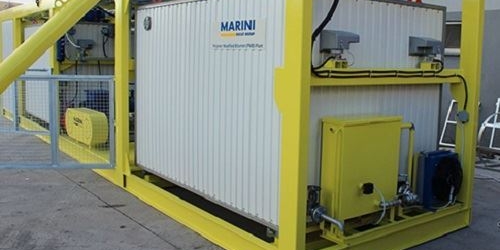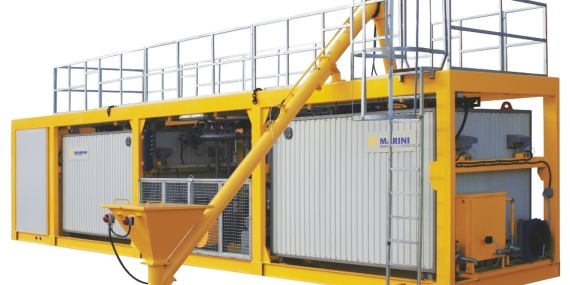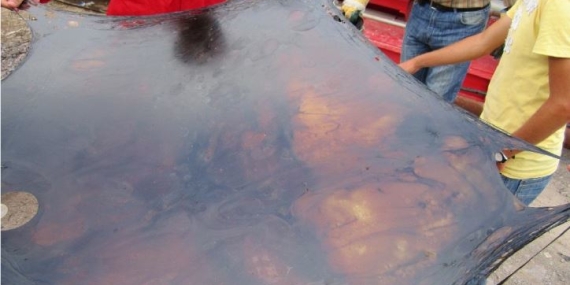THE PLANT
The plant is specially designed for polymer modification of bitumen with a capacity up to 40ton/h (theoretical capacity, with 5% SBS granular polymer and bitumen temperature at 180°C) and is fitted into a containerized body for stronger structure and easy transportation.
It is very flexible and can be adapted to any jobsite thanks to its special lay-out. The batch production can vary from 1 to 6 tons, and the number of passes through the mill can vary, depending on the percentage of polymer required to modify the bitumen.


POLYMER MODIFIED BITUMEN
Production of hot asphalt mixes with Polymer modified Bitumen (PMB) is mandatory for enhancing the performance of bitumen used in road, runway and racetrack applications both by improving life expectancy and reducing maintenance levels.
There are 4 important issues for good quality PMB:
Bitumen quality, polymer compatibility (the most used polymer is SBS), mill performance (a high quality mill with high power is fundamental to grant the perfect blending of polymer and bitumen) and good agitation of the final product (which is guaranteed by two agitators in each tank).
What is the process to produce PMB?
First of all we have to prepare the raw materials before the mixing process. The bitumen is heated to 170-180°C in bitumen service tanks. Bags of pre-weighed polymer are counted and placed in proximity to the feeding screw in accordance with the productions specs.
At this point, production of PMB with the modiFALT 20 plant is ready to begin.
The bitumen is pumped from service tanks to T1 or T2 (weighing & mixing tanks) via P1 (filling pump) according to required batch weight. After the minimum batch quantity has been transferred to the weighing tanks, the polymer metering systems are started up and the operator begins to load the bags into the designated hoppers.
The operator confirms via push-buttons that all the polymer has been loaded according to specs and batch quantity.
The bitumen weight is checked by the PLC control system according to specifications/batch quantity. If the polymer quantity has not been fully loaded by the operator, the PLC stops the filling operation of the P1 pump and waits for polymer confirmation. When the exact amount of polymer has been confirmed, the PLC automatically completes the tank weight to the total of bitumen + polymer. For improved disintegration of the polymer in the bitumen with the high shear mill, the polymer and bitumen mixtures have to be pumped to the mill without waiting.
When all bitumen and polymer is loaded into the tank, the PLC starts to pump out the two components via P2 (mill feeding pump) and D (high shear mill) to the PMB service tanks. The quality of the mill is essential for ensuring a high quality final product and, for this reason, a 160 kW high shear mill is advisable, which guarantees the production of modified bitumen with just a single-passage modification process (for high percentages 2 passes are recommended).
Under PLC surveillance, while P2 pumps out existing bitumen-polymer mixture, P1 fills the other tank for the next batch. These stages are automatically repeated to the end of the modified bitumen production process.
Storage: PMB blends must be stored in special PMB agitation tanks. To prevent polymer agglomeration, a stirring system is operated for 5-10 minutes every hour. To improve the stability of the blend, the tank content must be maintained at a temperature of 160-180°C.
PMB must be heated to the correct mixing temperature for the hot asphalt mix, and during asphalt production PMB should be stirred continuously by the agitators or at least kept in recirculation.

BLEND QUALITY CONTROL
The method for establishing whether or not the polymer has been completely dissolved is the ‘stretched film’ test: un-dissolved/swollen particles appear as dark spots when a thin film of the blend is viewed with transmitting light.
The polymer has dissolved completely when there are no more physical particles of polymer present in the blend. The time required depends on the efficiency of the previous stages, the chosen bitumen and the chosen polymer grade, but is usually independent of the batch size.
The above method gives a certain indication of the results, but to be able to determine the exact mixing time, and the number of passages required through the mill, further lab testing is required, such as dynamic viscosity.


